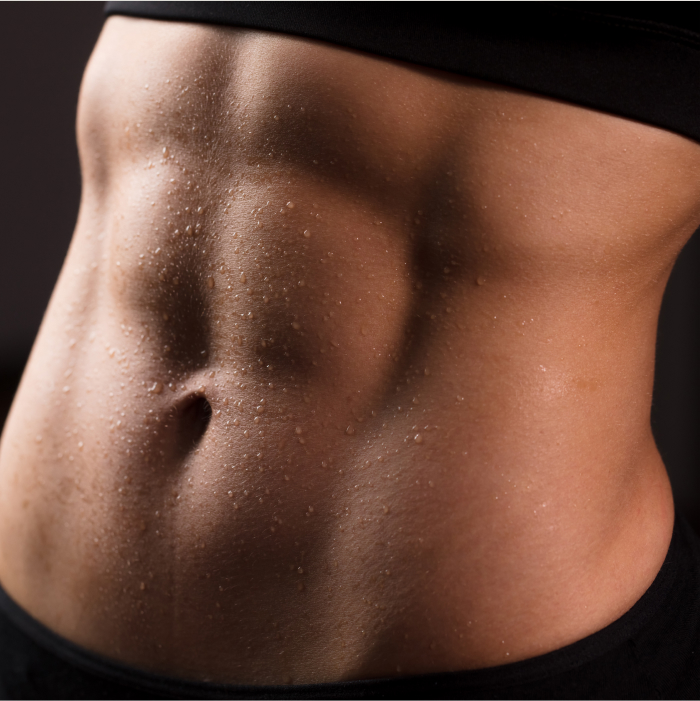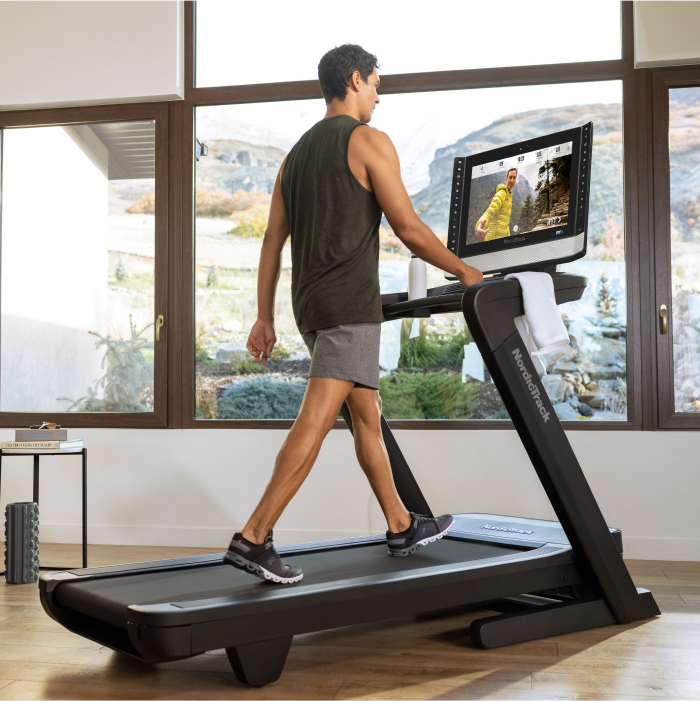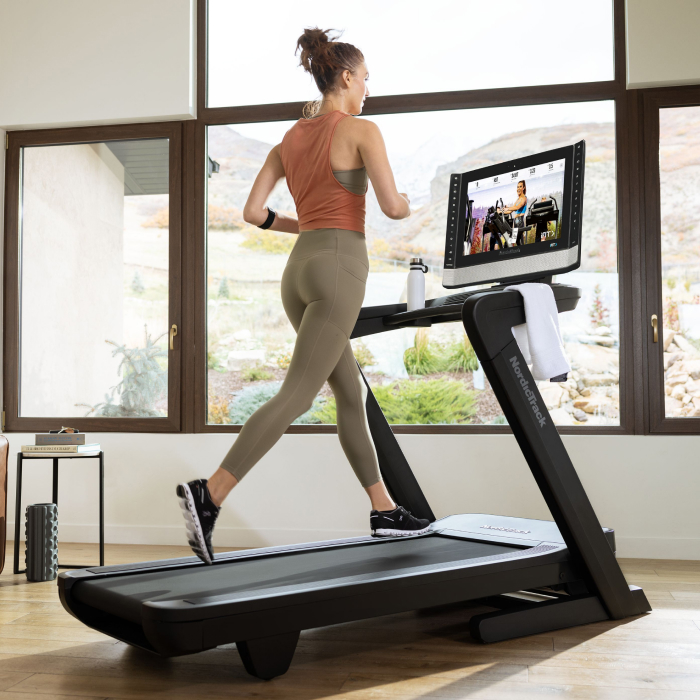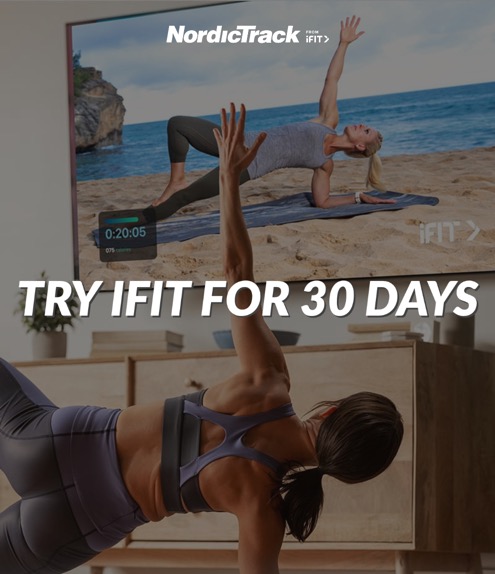
If you Google the phrase “treadmill workouts for targeting abs,” you’ll likely find thousands of results staring back at you.
But is it possible to target your abs on a treadmill?
And, can you get abs from a treadmill workout if you do it consistently enough?
Since those questions come up so frequently, we decided to answer them in this article using science-backed research to end the debate.
We’re also answering questions like:
- How do I target my abs on a treadmill?
- Can you lose belly fat walking on a treadmill?
- How can you get a flat stomach on a treadmill?
On top of those great questions, we’ll also explore what it really takes to lose stubborn belly fat, especially as you age, and share our top treadmill workouts for weight loss.
Before we get to the treadmill workouts for targeting abs, we’ll first cover the following:
How to Target Stubborn Belly Fat in General, According to Research

You’ve probably heard the popular phrase, “Abs are made in the kitchen,” but research from Johns Hopkins Medicine shows just changing your diet alone isn’t enough to eliminate belly fat.
On top of that, Harvard Health also mentions that where you store fat is based on several factors, including how old you are, your hormones, your genetic makeup, whether you’ve had kids, and even how much you weighed at birth.
Trying to spot reduce with endless amounts of core-specific moves like sit-ups and crunches may help tighten your ab muscles, as that same research in Harvard Health points out, but you’ll need to do more than that to remove any layer of fat, including visceral fat, sitting on top.
So what will do the trick?
Combining diet and exercise, instead of only focusing on one or the other, may be your biggest levers to pull when it comes to losing stubborn belly fat.
We’ll start with the diet tweaks to make before moving on to what exercises to do:
Dietary Adjustments to Make to Reduce Belly Fat

While it’s impossible to target belly fat specifically with diet alone, that doesn’t mean you shouldn’t care about what you eat.
Research presented in Johns Hopkins Medicine shows that having a larger waistline increases your risk of developing serious health conditions like diabetes, heart disease, and even cancer.
So, from a health standpoint, improving what you eat can have long-lasting positive effects past just having a smaller stomach.
Switching to a lower-carb diet that prioritizes high-fiber vegetables and solid protein sources may help you lose weight, according to that same research from Johns Hopkins Medicine.
In the study, people either went on a low-carbohydrate or low-fat diet for six months.
Calories were kept the same in each group.
Despite eating around the same amount of calories, the low-carb group lost 10 pounds more than the low-fat dietary group, and their fat loss percentage was higher than the low-fat group.
Losing weight, in general, and according to Harvard Health, can help you tone your midsection by decreasing the amount of visceral fat that sits around vital organs in your core.
This type of fat fills the spaces between your intestines, liver, and other essential organs. It also contains biologically active cells that can increase inflammation levels and increase risks for heart disease, according to Harvard Health.
Having excess visceral fat can also lead to hormonal disruptions, as that same research in Harvard Health points out.
So eliminating this fat type is critical from a health standpoint.
Keep in mind, this doesn’t mean you need to follow an extremely low-carb diet like keto.
Rather, swapping out high-carb foods like bread and bagels, which are low in fiber, for higher-fiber options like vegetables may help you lose weight, according to Johns Hopkins Medicine.
Avoiding processed foods packed with sugar, salt, and refined flour is also a good idea since they’re often void of nutrients and really easy to overeat, making it challenging to lose weight.
On the flip side, prioritizing protein and vegetables in your meals can help keep you satiated instead of ravenous for more, which can help with achieving your weight loss goals.
Once you have the nutrition portion down, you can combine this with exercise to maximize your tummy-toning results.
How to Use Exercise to Target Your Abs

Exercise is an excellent tool for preventing unwanted weight gain and helping to reduce it.
In one study presented in Johns Hopkins Medicine, researchers compared three different approaches to weight loss in 33 older women who were all obese and had type 2 diabetes.
Participants were separated into three groups: one followed a low-calorie diet only, another followed a low-calorie diet with walking 50 minutes three times per week, and the third only walked.
After 14 weeks, the researchers discovered that the low-calorie approach did not do enough to lose belly fat.
However, people in the walking-only and walking groups who also went under a lower-calorie diet lost the same weight in their midsection.
Another body of research from that same Johns Hopkins Medicine article just mentioned on 175 people over six months found that those who didn’t exercise gained more belly fat over that time, while those that moved more lost weight in their midsection, and they also prevented weight gain from happening there.
Additional research presented in a different article from Johns Hopkins Medicine mentioned that one of the reasons exercise helps shed belly fat is because it decreases circulating insulin levels.
They also mentioned that, having high amounts of insulin sends signals to the body to hold onto fat, whereas exercising helps turn your muscles into a sponge where excess glucose is soaked up and used instead of being left to float around in your system and wreak havoc.
Now that you know how effective exercise is for targeting abs, the next questions that often arise are: is aerobic exercise better for belly fat? Or, is strength training a better tool here?
Aerobic Exercise vs. Strength Training for Belly Fat

30 to 60 minutes of moderate-intensity exercise (biking, walking on a treadmill, etc.) may help burn abdominal fat, as Harvard Health pointed out.
But the results are even more effective and pronounced when you add strength training or resistance workouts, which may help you build lean muscle mass and burn more calories, according to Johns Hopkins Medicine.
In one study done on 104 men and women over six months, people were divided into groups where they either didn’t exercise, or they walked on a treadmill, or rode their bikes. Those who exercised also added strength training workouts between their cardio days.
Study participants who exercised lost an average of five pounds, which may not seem like much, but it specifically led to a whopping 18% drop in belly fat. They also decreased their risks for metabolic issues like high blood pressure, insulin resistance, and obesity, according to the research presented in John Hopkins Medicine.
Those researchers concluded that opting for aerobic exercises five times per week for 30 minutes plus weaving in three strength training sessions per week was the secret sauce to these incredible results.
Another body of research, this time from Harvard Health, echoed these findings.
When comparing 10,000 men over 40, those who also did 20 minutes of strength training each day had less age-related weight gain in their midsection compared to those who only did aerobic exercises.
So, for maximum results, it’s best not to choose one method over the other and instead weave in a combination of both throughout your week.
If you’re looking for an easy way to do just that, check out iFIT, a separate paid subscription service that offers thousands of aerobic and strength training workouts to choose from.
Exercise with top trainers across the globe, and you’ll find it’s easy to combine strength training and aerobic exercises throughout your week.
Lastly, another question that often comes up regarding working out and losing weight around the midsection is, do you need to train for long periods to see results? Or, are short workouts just as effective?
Short Bursts of Training vs. Long Training Sessions on Belly Fat
Whether you opt for longer or shorter workouts, if the calorie burn is roughly the same, you may lose the same amount of belly fat.
Where things get interesting is that researchers from Harvard Health found that performing short bursts of intensity training, such as HIIT, or high-intensity interval training, may help you manage blood sugar levels better.
In this study, 300 people with extra weight around their midsection walked or jogged on a treadmill at a moderate or high-intensity pace.
Both groups burned about the same calories and lost an average of 1.75 inches from their midsection and about 5 to 6% of their body weight.
Because the calories were so evenly matched, it made no difference whether study participants went at a higher or lower intensity.
Simply getting in enough of a workout helped them notice a difference.
But, if you are low on time, short-and-sweet 20-minute workouts can still be an effective tool to help you get a workout in.
One more important area that can help with weight loss and belly fat specifically is staying active throughout your day, according to Harvard Health.
While it’s important to spend 30 to 60 minutes working out each day, it’s also crucial that you’re weaving in some movement throughout your day too.
Studies from Harvard Health show that both forms of exercise – a planned workout and keeping active throughout your day – are essential for decreasing belly fat and controlling any age-related weight gain.
How to Target Abs on a Treadmill
Whether you’re trying to target abs on a treadmill or any other workout, the key is not focusing on spot reducing and instead shifting your attention to engaging your core.
You may not realize that having a weak core can lead to more problems than just excess weight around the midsection.
It can cause your posture to unnaturally shift, leaving your head protruding forward too much or adding too much curvature to your spine, according to Harvard Health.
All of this can lead to shoulder, neck, and back pain.
To avoid that from happening, one of the best things you can do while exercising and moving around throughout your day is to properly engage your core.
Before performing any exercise, practice what’s known as 360, or diaphragm breathing, where you inhale and fill up your lungs and abdominal cavity in a way that expands all around your midsection.
Then, as you exhale, pull your abs in and zip them up nice and tight.
You’ll often hear this as pulling your belly button up and in towards your spine.
This is how you properly engage your core throughout any workout, and it can also help you target abs on your treadmill workouts.
Keep in mind you should continue to breathe normally, as opposed to holding your breath, as you engage your core.
To take things a step further, check out the following:
4 Treadmill Workouts for Targeting Abs

If you’ve read this entire article so far, you know by now that you can’t spot reduce belly fat.
But, what you can do is focus on losing weight overall and devoting time to regular exercise.
Given enough time, exercise, and proper nutrition, you may be able to decrease the weight around your midsection too.
One way you can get started with the exercise piece of the puzzle is to browse done-for-you workout programs from iFIT.
iFIT, a separate paid subscription service, offers thousands of great workouts to choose from, including these four below:
- St. Lucia Walking Series
- Italy Walking Series
- Hawaiian Islands Toning Series
- Adriatic Sea Interval Series
For anyone just starting with exercise, this beginner treadmill workout flow chart will help you safely ease into working out.
And for those reading this who are ready for an advanced workout, the popular 12-3-30 workout, which you can read about by visiting that link, might be a good option.
The Bottom Line
As you’ve seen from reading this article, there are several things you can do to help prevent unwanted weight gain in your midsection, and there are just as many ways to help you get rid of it.
The key is to combine your dietary changes with aerobic exercises and strength training throughout your week.
Consistently tackling these important items will not only help you trim the belly fat, but they’ll also help improve your overall health, which is a win in both the short and long term.
Disclaimer: This blog post is not intended to replace the advice of a medical professional. The above information should not be used to diagnose, treat, or prevent any disease or medical condition. Please consult your doctor before making any changes to your diet, sleep methods, daily activity, or fitness routine. iFIT assumes no responsibility for any personal injury or damage sustained by any recommendations, opinions, or advice given in this article. Always follow the safety precautions included in the owner’s manual of your fitness equipment.


